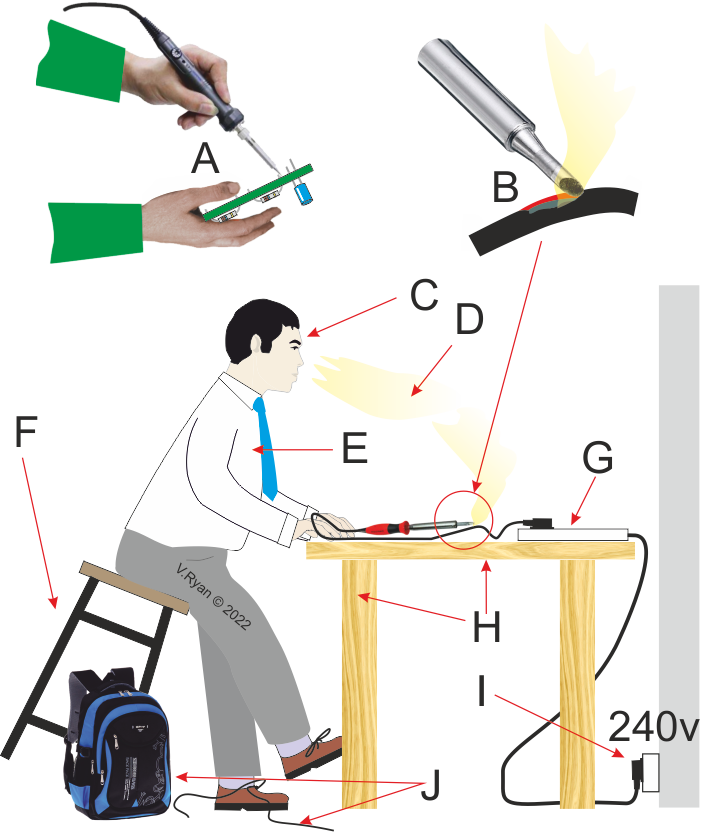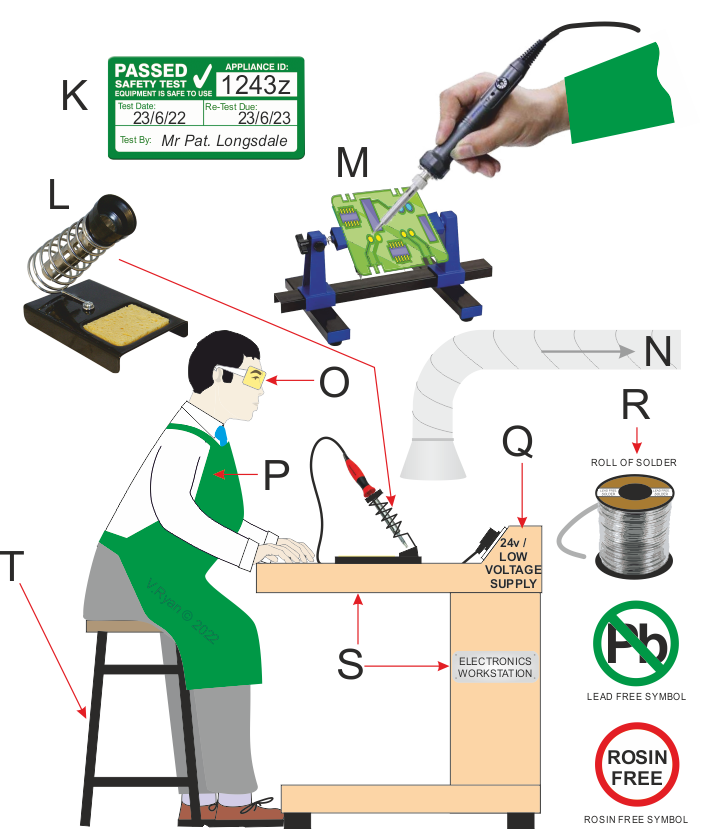
A. Never hold a printed circuit board in the hand, whilst soldering. An accident can easily result from a slipping hand. The PCB should always be clamped in a PCB holder, so that it cannot move.
B. Never lay down a soldering iron directly on the bench / table top. The soldering iron must always be placed in a soldering iron holder / stand. When buying a soldering iron, ensure has a Silicone Heat Resistant power cable. In the event of accidentally lying the soldering iron tip across the cable, it will not burn through to the live wires. Burning through a live cable can result in serious consequences, such as electrocution.
C. Always protect your eyes when soldering. Hot solder can ‘spit’ in any direction.
D. Do not allow fumes to form. Use extraction to take away fumes and if extraction is not available, open windows, allowing a flow of clean air and ventilation.
E. Wear an apron or lab coat, to protect your clothing and you.
F. Sit on a stool, set at a suitable height. Ensure that all four legs are in contact with the floor.
G. Try to avoid using extension leads, as this will mean that there are long electrical cords, which are a trip hazzard. If plugging into the mains, use an RCB (Residual Circuit Breaker). If the RCB detects an electrical problem, it will trigger, switching off power.
H. Use a bench suitable for soldering. A bench with a heat resistant top. A soldering iron has a very hot tip and if it contacts the bench top, it will be damaged and can even burn.
I. If possible, use a 24v soldering iron. 240 volt soldering irons can be used, but because of their much higher voltage, they often not used in schools or with young people. Turn the power off when soldering is not taking place. Always use an RCB (Residual Circuit Breaker).
J. keep to all safety rules, even checking your laces are not loose and storing bags, either could be a trip hazzard.

K. All electrical equipment should be PAT tested (Portable Appliance Testing) every year. PAT tests ensure that they are electrically safe to use. Look for the PAT Testing label, which should be stuck on to all electrical equipment.
L. Use a soldering iron stand. This holds a hot soldering iron safely and in a position where by it can be picked up, without a risk of burning a hand. Never touch the hot element! The stand should have a built in sponge, for cleaning the soldering iron tip, before and during the soldering procedure.
M. When soldering, place the circuit in a circuit holder. Never hold the circuit in one hand, whilst soldering with the other. A holder makes the soldering process easier and safe.
N. Where possible turn extraction on. This will remove any fumes from the atmosphere within the workshop. Extraction is required were soldering is carried out continuously. If only small amounts of soldering are taking place, windows should be opened to allow the escape of fumes.
O. Goggles / eye protection is important, when soldering.
P. Wear a workshop apron or work coat.
Q. A 24 volt supply is the safest option, for soldering irons, especially for younger pupils. Most people studying electronics still use 240v soldering irons as they heat up quickly and are effective. Turn the supply off, when soldering is not taking place. Use an RCB (Electrical Circuit Breaker) or an electrical bench that has one built in.
R. Use solder that is lead and rosin free. Both rosin and lead can be dangerous. Rosin can cause eye, throat and lung irritation. It can even cause nose bleeds and headaches. Lead is potentially extremely dangerous and has not been used in solder for some time.
S. Use a table / surface specifically design to resist heat and equipment such as hot solder iron tips. tables / benches designed for electronics are available. Some even have a 24 volt power source.
T. When soldering sit down on a stool / chair, set a comfortable height.
OTHER ADVICE
Wash you hands after soldering.
Soldering must be supervised by your teacher.
Always inspect the soldering iron and its lead, before soldering. Report damage immediately to your teacher.
Keep the work surface tidy and clear of any unnecessary equipment.
Short lengths of solder, that cannot be held safely, should be placed in a container for disposal.